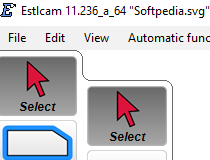


I hope this helps clarify the difference between 2.5D and 3D, and why you might want to keep it simple for basic engraving and carving CNC machines such as the MPCNC and others.Video CNC Kenny Assignment: Make something big Hero Shots Not a bad choice, just different set of trade-offs. The trade-off is that the learning curve will be steeper, so there will be more frustration and mistakes in the beginning. You’re unlikely to ever outgrow it, and it will be useful to know for just about any CNC machine. It’s certainly a capable program and has excellent support in the CAD/CAM world. Having said all of this, you might still want to start with a fully 3D program such as Fusion 360. I have stuck with it because I’ve been able to get it to do whatever I’ve needed it to do so far. It’s also reasonably priced and is actively supported by it’s creator, Christian Knüll.
Estlcam svg software#
Having support between the software and hardware is a very good thing. I chose Estlcam because it is well supported in the MPCNC community. Within Estlcam, I create the tool paths which will be used by the CNC machine, which it outputs as gcode. Next, I import the ‘.svg’ file into a program called Estlcam.

I find Designer to be easy and powerful to use, and I like that it is very affordable. I personally use Affinity Designer to do the 2D design and output into a. The most common way to do this to output from your 2D design software into a ‘svg’ format. in another software tool) from the 2D design into gcode which your CNC machine can use to operate. This assumes that it can output the design in a format which can be processed in a later step (i.e.
Estlcam svg how to#
You should be able to get to work sooner because you already know how to do basic designs in your preferred tool. If you are already familiar with a 2D design software such as Adobe Illustrator or Affinity Designer (there are many others), then you can speed up your learning curve by starting with these programs. You can start with carving lettering or other designs into the surface to make signs, for example. For the novice in CNC, there’s enough to learn already, so it makes sense to me to start simpler with tools that are easier to learn and to get working.Īn example of the kind of work that you might start with using your first CNC engraver is to carve designs into a flat surface. I say this because 3D modeling generally has a longer learning curve. If you’re just starting out in CNC, it’s probably best to start with 2.5 D instead of 3D for modeling. Most people think that they need a full-featured 3D design program in order to design parts for their CNC milling machine. This is a big deal when you’re thinking about design software. But if you want to make a fully 3D part, you are limited because you can only cut on the top of the part.īecause you can only cut on one face in the Z axis, this is called 2.5D CNC. This is great for carving, engraving, drilling, cutting sheets, leveling, and similar tasks. This seems like 3D, but it can only carve into one side of the work-piece, which is the top. The engraving tool moves about in the X and Y directions ( right and left is usually the X axis, while front and back is usually the Y axis) and also moves up and down in the Z axis to carve into the work-piece. Most of the CNC machines that a beginner is going to use have a flat area, and an engraving or carving tool that moves above it. I assumed that since the machine has an X, Y, and a Z axis, that I needed to learn 3D design programs. When I was starting with CNC, I was overwhelmed by all the options when it comes to software which is used to design, layout, and control the CNC machine. If you’re just getting started in CNC, it’s important to know the difference between 2.5D and 3D machining.


 0 kommentar(er)
0 kommentar(er)
